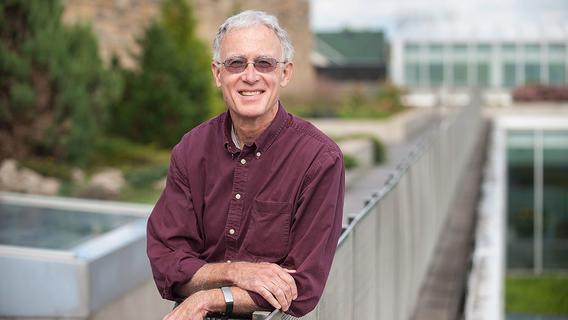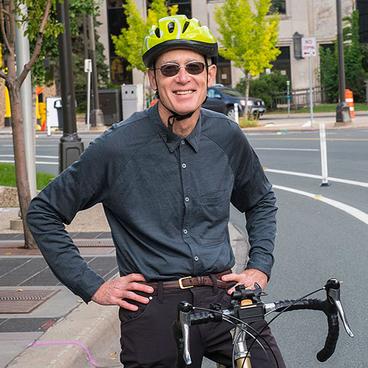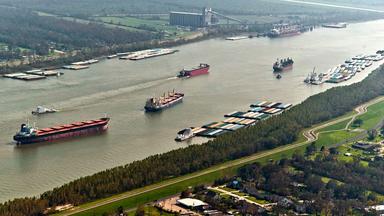
By Ann Nordby
Professor Greg Lindsey has always taken a practitioner's perspective to research and teaching. That approach has been a win-win for students at the Humphrey School of Public Affairs, but also for numerous local communities and for his field.
Lindsey is retiring this summer after 16 years at the School—as a leader who has helped shape the School’s graduate degree programs, as a faculty member in the urban and regional planning area whose expertise in bicycle and pedestrian traffic is highly regarded, and as a researcher who is committed to community-engaged scholarship.
Leadership role
Lindsey came to the Humphrey School in 2008 as associate dean, after serving more than 15 years as an administrator and faculty member at Indiana University Purdue University Indianapolis (IUPUI).
Over the next four years he helped lead the School as associate, interim, and executive associate dean. He had a hand in designing the School’s PhD in Public Affairs program, the Master of Development Practice (MDP) program, and the cohort structure of the mid-career Master of Public Affairs (MPA) program.
Lindsey was director of the PhD program and has taught core courses in several of the School’s master’s degree programs. But his most significant impact is in the urban and regional planning area, where his research has shaped the ways state and local governments plan for nonmotorized travel by bicyclists and pedestrians.
Numerous public agencies, including the Minnesota Department of Transportation (MnDOT), the Department of Natural Resources, and Hennepin County, have implemented new monitoring programs to measure bicycling and pedestrian traffic volumes, based on research by Lindsey and his students.
He has designed myriad research projects throughout his career, always with an eye to applying the knowledge revealed. One recent example is a study he conducted in 2022, to assess how the COVID-19 pandemic impacted biking and walking in Minnesota.
Community-engaged research
Lindsey was an environmental advocate, consultant, and public administrator for nine years before obtaining his PhD and beginning his 30-year career in academia.

Perhaps due to these early experiences, he always incorporated two things into his research designs and teaching: hands-on learning for students and service to local communities.
"All of my classes, and particularly the capstone classes, are designed around that," Lindsey said recently.
Most Humphrey School students complete a capstone project that culminates their learning experience. In the capstone, students work in small groups to research and analyze a topic for external clients from the public or nonprofit sector. Lindsey has advised many students on their capstone projects, connecting them to meaningful work experiences that benefit real people.
When he was starting out as a professor in Indiana, Lindsey developed a way for students to do research design, field work, data analysis, report writing, and presentation of their results to local governments.
In doing so, the students shared new knowledge to local officials, such as how many people were using their public facilities. "It became my motif," he said.
Many of the Humphrey School’s capstone projects have been in support of underserved local communities. For example, some of Lindsey’s students recently developed designs to address pedestrian safety in the communities of Redby and Red Lake on the Red Lake Nation reservation in northern Minnesota.
Their work complemented two research projects Lindsey led for MnDOT over the past eight years that studied pedestrian risk on the seven federally recognized Anishinaabe reservations in the state.
Along with tribal transportation leaders and MnDOT collaborators, Lindsey and his students assessed pedestrian risk at more than 20 highway crossings on tribal lands. They then recommended countermeasures such as crosswalks, beacons, and signage to make the highway crossings safer. The final report for these two projects has just been published, and many of the safety improvements have already been implemented.
Humphrey School impact
Lindsey is proud of the work his students have done, both inside and outside of the classroom.
"Their capstone projects have made an impact, and given these students the skills to build successful careers," he said, noting that many graduates have gone on to work in state departments of transportation around the country.
Over the years, Lindsey’s leadership helped to build the programs that the Humphrey School offers today. The PhD program now has about 30 students and 27 graduates around the world, working as professors and research scientists.
Lindsey’s years in the Humphrey School dean’s office from 2008 to 2012 included stints as associate dean and nearly a year as interim dean. During that time he oversaw student recruitment, a job made easier than in many other places by the bright job prospects here. Minnesota employers have a track record of hiring Humphrey School graduates.
"There is a demand for curious, energetic people who want to change the world," he said of local governments and public agencies. "People here are very willing to give them opportunities."
As an example of the types of work Humphrey School students do that makes them competitive in the job market, Lindsey noted one team of MPA students who studied the Brooklyn Park, Minnesota, police department to develop strategies to diversify its police force. At the time, 100 of the city's 105 police officers were white, while the majority of its residents were people of color.
"My students analyzed their recruitment practices, and wrote their capstone report on it," Lindsey said. This was in 2019, before the pandemic shone a harsh light on the inequities built into many police departments.
"Students come to Humphrey because they want to change the world. We design capstone opportunities with agency partners so that they get a chance to do that. And they can do that; they have the capacity to change investment decisions that are being made,” Lindsey said. “That's the strength of the school and our programs. It's a hallmark of what the Humphrey School does."
Lindsey's approach perfectly reflects the University of Minnesota's tripartite mission of research, service and teaching. At the Humphrey School, that mission shows up throughout the student experience. Even better, the University enjoys strong support throughout the state.
"My students have undertaken projects with public agencies and then gone on to work with them. People here in Minnesota are very willing to give them opportunities,” Lindsey said. “The commitment to experimentation and innovation is greater than in most places. People here will go out on a limb.”
As an example, Lindsey said, Minnesota is among the top five or six states in the country for nonmotorized transportation and "a national leader in transportation equity. State leaders are willing to ask the questions and admit the wrongs of the past in order to fix the problems of today,” he said. “That does not happen in some states."
Recognition
Lindsey's contributions have earned him numerous accolades for his teaching, research and administration. He received the University of Minnesota President’s Community-Engaged Scholar Award in 2019, was a Scholar in Residence with MnDOT, and four times received best paper awards from the Transportation Research Board.
Lindsey was elected a fellow of the National Academy of Administration in 2015. He has published dozens of research papers and served as a peer reviewer for many more, and has served on numerous commissions.
Even though he’s officially retiring, Lindsey says he will continue to work on traffic safety issues in Indian Country, and on bicycling and walking. Doing so will keep him involved in the impactful work he has found so rewarding.
It will also keep him close to his beloved Lutsen, Minnesota, on the North Shore of Lake Superior, and to his extended family in Minnesota, his adopted home.

